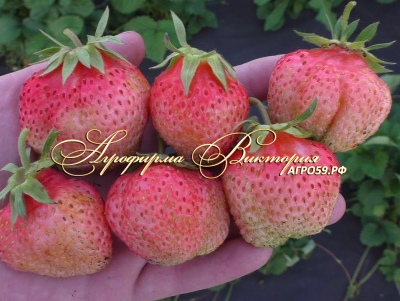
- Authors: Finland
- Taste: nectar-sweet
- The size: large and medium
- Yield rate: high
- Ripening terms: mid-late
- Appointment: fresh consumption
- Description of the bush: high, semi-spreading, dense
- Berry color: white-pink
- Winter hardiness: winter hardy
- Height and width of the bush: height from 10 cm to 15 cm
Despite the harsh climate in Finland, strawberry cultivation is one of the most important branches of its agriculture. Strawberry plantations cover about 4,000 hectares of land. The fragrant berry grows even in Lapland. The strawberry variety, which is called Finnish pink, has remarkable taste.
Breeding history of the variety
The production of garden strawberries has been on an industrial scale in Finland since the 1960s. Since then, Finnish farmers have been pleased to invite workers from all over the world to harvest their crops. It is believed that the Finnish pink strawberry was brought to Russia by seasonal berry pickers and spread first in border Karelia, and then throughout the country.
The original Finnish name of the variety is unknown. Mainly on Finnish plantations, hybrids of British, Czech, Dutch origin are cultivated. The Finnish rose is similar in many respects to the characteristics of the Pineberry variety, bred by the Dutchman Hans de Jong. True, Pineberry appeared in 2009, and its Finnish "sister" - much earlier, in the Soviet years. Following the Pineberry, many varieties of pink and white berries have emerged in Europe and Japan.
In the USSR, the Pineapple 1976 variety bred in a domestic nursery was popular. The giant berry was distinguished by its sugar taste and pale pink color. Modern Pineapple most often has medium-sized fruits. But due to the common features of the Finnish pink and Pineapple varieties, they are often confused and identified.
Description of the variety
Finnish pink is a very productive, winter-hardy, large-fruited variety. Large and fragrant light pink berries have a nectar-sweet taste, but poorly stored and transported due to their delicate consistency.
Ripening terms
The variety is distinguished by its mid-early ripening period. The fruits mature by mid-June.
Growing regions
Many territories are suitable for this variety. It is widespread in the Leningrad region and the Moscow region, it grows well even in Kamchatka. The variety is hygrophilous, therefore it is not recommended only for arid, hot areas.
Yield
Strawberries form a semi-spreading, tall (10-15 cm) bush with large light green leaves. It has a high yield, there can be up to 15 berries on a brush.
Berries and their taste
The berries are pinkish-white in color, greenish at the tip. When fully ripe, they become brighter, completely pink. Dessert pulp, very sweet, juicy and melting in the mouth. The inside of the berry is loose, light, almost white, maybe with a void in the core. The first berries in the season will be especially large.
Experienced amateur gardeners buy Finnish rose bushes not for further market sale of the crop, but only for personal use, because many buyers have a prejudice that the sweetest strawberries should be bright red. The pale berries of the Finnish variety look unusual, they seem unripe. In addition, due to the delicate skin and pulp, the variety is absolutely non-transportable. The most correct decision is to eat sugar fruits immediately after removal from the bush.The variety is not suitable for preparing blanks for the winter in the form of compote.
Growing features
The cultivation of the Finnish rose on a large scale is not carried out in Russia. It can only be found in private garden plots. With a small amount of rain, abundant watering is needed. Growing according to the Finnish method (with film) allows you to get a harvest 7-8 weeks after planting. This frost-resistant variety does not need additional shelter for the winter season.
Many summer residents, due to their inexperience and ignorance of the features of the Finnish rose, are faced with the problem of overripe berries.




Site selection and soil preparation
For planting, an open, sunny place with no shade from buildings and vegetation is chosen. Dig up the soil, remove dry foliage and weed roots, break large clods with a rake.
The short and cool summer of the country of Suomi became the reason for the emergence of original technologies for growing strawberries. One of the main methods is to use a black film as a mulch cover. The film is rolled over the formed beds, holes are cut every 30 cm, and the seedlings are placed.

Pollination
The culture is self-pollinated, which does not require artificial transfer of pollen when planted in open ground.
Top dressing
Humus, compost, and manure are traditionally used to fertilize the soil. Mineral dressings are also used (30-40 g / sq m).

One of the important techniques in strawberry care is feeding. Regular fertilization guarantees a rich harvest. There are several different ways to feed strawberries, and each of them is designed for a specific period of plant development. During flowering, fruiting and after it, feeding should be different.

Diseases and pests
The variety is quite good at resisting diseases and pests. Sometimes it is affected by leaf spot. Prolonged rains can cause rotting berries, they must be picked in a timely manner.

Strawberries are often subject to many dangerous diseases that can seriously undermine their condition. Among the most common are powdery mildew, gray mold, brown spot, anthracnose, and verticillosis. Before buying a variety, you need to inquire about its disease resistance.
Reproduction
Strawberries reproduce by abundant lateral shoots - whiskers, on which young rosettes are formed. You can dig a peat pot into the ground, fill it with seedling mixture, and put a new outlet there with the roots that appear. When the bush takes root and forms a developed root system, it is separated, cutting off the maternal mustache, and planted.



















































































